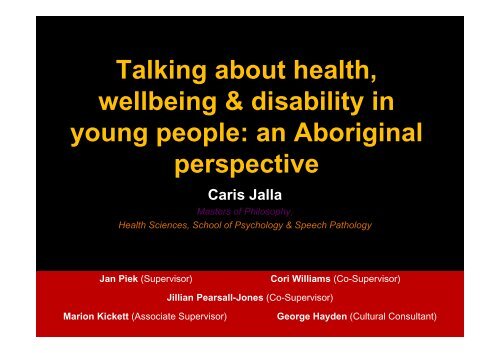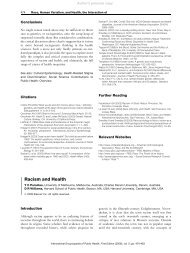Talking about health, wellbeing & disability in young people: an ...
Talking about health, wellbeing & disability in young people: an ...
Talking about health, wellbeing & disability in young people: an ...
- No tags were found...
You also want an ePaper? Increase the reach of your titles
YUMPU automatically turns print PDFs into web optimized ePapers that Google loves.
<strong>Talk<strong>in</strong>g</strong> <strong>about</strong> <strong>health</strong>,<strong>wellbe<strong>in</strong>g</strong> & <strong>disability</strong> <strong>in</strong><strong>young</strong> <strong>people</strong>: <strong>an</strong> Aborig<strong>in</strong>alperspectiveCaris JallaMasters of Philosophy,Health Sciences, School of Psychology & Speech PathologyJ<strong>an</strong> Piek (Supervisor)Cori Williams (Co-Supervisor)Jilli<strong>an</strong> Pearsall-Jones (Co-Supervisor)Marion Kickett (Associate Supervisor)George Hayden (Cultural Consult<strong>an</strong>t)
OVERVIEW• Background• Objectives & Signific<strong>an</strong>ce• Methodology• SummaryImage from ‘Two Mates’ by Mel<strong>an</strong>ie Prewett
The way we look at <strong>health</strong>…
Aborig<strong>in</strong>al <strong>people</strong> & <strong>disability</strong>• In 2008, one-half of Indigenous adults hadsome form of <strong>disability</strong> (ABS, 2010)• Around 8% of those aged 15 years or olderhav<strong>in</strong>g “profound or severe core activitylimitation”• In 2008, the proportion of profound or severecore activity restrictions among Indigenous<strong>people</strong> was slightly higher <strong>in</strong> remote areas(8.1%) th<strong>an</strong> <strong>in</strong> non-remote areas (7.9%).(SCRGSP, 2011)
Aborig<strong>in</strong>al <strong>people</strong> & <strong>disability</strong>• The 2008 National Aborig<strong>in</strong>al <strong>an</strong>d Torres StraitIsl<strong>an</strong>der social survey (NATSISS) found thatalmost one-<strong>in</strong>-ten Indigenous children had <strong>an</strong>eye or sight problem (ABS, 2009)• The Western Australi<strong>an</strong> Aborig<strong>in</strong>al Child HealthSurvey (WAACHS) reported that almost onefifthof Indigenous children had recurr<strong>in</strong>g ear<strong>in</strong>fections (Zubrick et al., 2004)
Aborig<strong>in</strong>al <strong>people</strong> & <strong>disability</strong>Disability as def<strong>in</strong>ed by the ABS is a ‘limitation,restriction or impairment which has lasted, or islikely to last, for at least six months <strong>an</strong>d restrictseveryday activities’.Aborig<strong>in</strong>al perceptions of <strong>disability</strong>…?• Few studies purposefully research Aborig<strong>in</strong>alperceptions of <strong>disability</strong>• Current literature – all adults perspectives
Aborig<strong>in</strong>al <strong>people</strong> & <strong>disability</strong>• No word for <strong>disability</strong>• Don’t see themselves as hav<strong>in</strong>g a <strong>disability</strong>; or m<strong>an</strong>y notaware of <strong>disability</strong>• Traditionally not stigmatised• No difference between <strong>disability</strong> <strong>an</strong>d <strong>health</strong> issues• Congenial <strong>disability</strong> vs. accidents• May be seen as 'special' or a 'pay-back' for a pastwrongdo<strong>in</strong>g• Visible conditions more likely to be identified as a <strong>disability</strong>• Only <strong>an</strong> issue if condition became a h<strong>an</strong>dicap(Ariotti, 1999; Br<strong>an</strong>son, 1992; McDonald, 2009; Mokak, 1997; O’Neill et al.2004; Senior, 2000)
Aborig<strong>in</strong>al <strong>people</strong> & <strong>disability</strong>• Shame• Lack of <strong>in</strong>dependence may not be seen as a major issue <strong>in</strong>some Aborig<strong>in</strong>al communities if person fulfil family <strong>an</strong>drelationship obligations• Value mobility th<strong>an</strong> upper limb function• Responsibility of– welfare–a family or community problem (may not actively seekhelp)– self, dem<strong>an</strong>d no special attention or burden to community(Cl<strong>an</strong>cy, 2002; McDonald, 2006; Maher, 1999; O’Neill et al. 2004; Reg<strong>an</strong>, 2010;Str<strong>an</strong>ge, 2008)
Signific<strong>an</strong>ce• No literature on Aborig<strong>in</strong>ality + <strong>disability</strong>+ perspective of children <strong>an</strong>d <strong>young</strong><strong>people</strong>
Objectives• Investigate the me<strong>an</strong><strong>in</strong>g of <strong>health</strong>,<strong>wellbe<strong>in</strong>g</strong> <strong>an</strong>d <strong>disability</strong>• Explore facilitators <strong>an</strong>d barriers• Report on differences <strong>an</strong>d similarities
Methodology• Cultural consult<strong>an</strong>ts x 2• Reference group x 4• Ethics HREC & WAAHEC• Yarn<strong>in</strong>g (Bessarab & Ng’<strong>an</strong>du, 2010)• Consent from primary carers• Access counsell<strong>in</strong>g service• Audio-recorded, tr<strong>an</strong>scribed verbatim• Thematic <strong>an</strong>alysis with NVivo
Reference GroupJonath<strong>an</strong>FordRhonda MarriottMichelleSult<strong>an</strong>RachelVisser
Ethics• Reciprocity• Respect• Equality• Survival• Protection• ResponsibilityNational Health <strong>an</strong>d Medical Research Council Guidel<strong>in</strong>esfor Ethical Conduct <strong>in</strong> Aborig<strong>in</strong>al <strong>an</strong>d Torres StraitIsl<strong>an</strong>der Health Research
Yarn<strong>in</strong>g…Yarn<strong>in</strong>g supplemented with non-verbal expressions e.g. pa<strong>in</strong>t<strong>in</strong>g
Social yarn<strong>in</strong>g…Supplemented with nonverbalexpressionse.g. draw<strong>in</strong>g• Draw self/familyportrait <strong>an</strong>d describeyourself <strong>in</strong> three words• Timel<strong>in</strong>e of life(Bagnoli, 2009; Mohajer, Bessarab &Earnest, 2009)
Research yarn<strong>in</strong>g…• What does it me<strong>an</strong> to be <strong>health</strong>y?• What makes a good life?• Who c<strong>an</strong> help you live a good life?• What stops you from liv<strong>in</strong>g a good life?• Tell me <strong>about</strong> this girl….• What <strong>about</strong> this <strong>young</strong> bloke? Tell me<strong>about</strong> his life…• What would be the hardest th<strong>in</strong>g <strong>about</strong> hislife?• What would be the best <strong>about</strong> his life?• What th<strong>in</strong>gs or <strong>people</strong> do you th<strong>in</strong>k wouldhelp him have a good life?• Picture yourself as this <strong>young</strong> bloke, howdo you feel?
Particip<strong>an</strong>ts• 30 Noongar children <strong>an</strong>d <strong>young</strong> <strong>people</strong>• 10 to 25 years• Purposive sampl<strong>in</strong>g, snowball<strong>in</strong>g• Perth, metro (possible rural <strong>in</strong>clusion)• Without <strong>an</strong>d with disabilities– Primary diagnosis of sensory or physical
Milestones• C<strong>an</strong>didacy• Ethics (HR 19/2012 & WAAHEC 424)• Reference group, pilot yarn<strong>in</strong>g• Recruitment, Yarn<strong>in</strong>g circles• Analysis <strong>an</strong>d dissem<strong>in</strong>ation2011 – 2012 2012 – 2013 2013 – 2014C<strong>an</strong>didacy & ethicsReference groupPilot yarn<strong>in</strong>gRecruitment , yarn<strong>in</strong>gFollow up (validation) sessionsCommence <strong>an</strong>alysisDissertation &Dissem<strong>in</strong>ation
Summary• Aborig<strong>in</strong>al youths’ view on <strong>disability</strong>• 15 youths with disabilities• 15 youths without disabilities• Yarn<strong>in</strong>g method & thematic <strong>an</strong>alysis• Results to form recommendations to<strong>disability</strong> service providers
References• Bessarab & Ng’<strong>an</strong>du (2010). Yarn<strong>in</strong>g <strong>about</strong> Yarn<strong>in</strong>g as a Legitimate Method <strong>in</strong> IndigenousResearch, International Journal of Critical Indigenous Studies, 3 (1), 37-50.• Br<strong>an</strong>son J, Miller D. (1992). Normalisation, community care <strong>an</strong>d the politics of difference.Aust. Disabil. Rev, 4, 7–28.• Brown, R. (2001). Australi<strong>an</strong> Indigenous mental <strong>health</strong>. Australi<strong>an</strong> <strong>an</strong>d New Zeal<strong>an</strong>d Journalof Mental Health Nurs<strong>in</strong>g,10(1), 33-41.• Department of Health <strong>an</strong>d Age<strong>in</strong>g (2010). Work<strong>in</strong>g together: Aborig<strong>in</strong>al <strong>an</strong>d Torres StraitIsl<strong>an</strong>der Mental Health <strong>an</strong>d Wellbe<strong>in</strong>g Pr<strong>in</strong>cipals <strong>an</strong>d Practice’ Nola Purdie, Pat Dudgeon, <strong>an</strong>dRoz Walker (eds), C<strong>an</strong>berra, ACT.• Gilroy, J. (2009). Service delivery for Aborig<strong>in</strong>al <strong>people</strong> with a <strong>disability</strong> <strong>an</strong>d their families.Retrieved June 7, 2012 from http://www.nds.org.au/asset/view_document/979317563• Maher, P. (1999). Disability <strong>in</strong> the Australi<strong>an</strong> Aborig<strong>in</strong>al Population. Australi<strong>an</strong> Journal ofPrimary Health, 5(3), 10-20. Retrieved from• McDonald H. East Kimberley concepts of <strong>health</strong> <strong>an</strong>d illness: a contribution to <strong>in</strong>tercultural<strong>health</strong> programs <strong>in</strong> northern Australia. Aust. Aborig. Studies 2006; 2: 86–97.• Mokak, R. (1997). Aborig<strong>in</strong>al People <strong>an</strong>d Disability: What are the Issues <strong>an</strong>d Where Do WeGo from Here? Aborig<strong>in</strong>al <strong>an</strong>d Isl<strong>an</strong>der Health Worker Journal, 21(5), 14-15• O'Neill M, Kirov E, Thomson N (2004) A review of the literature on <strong>disability</strong> services forAborig<strong>in</strong>al <strong>an</strong>d Torres Strait Isl<strong>an</strong>der <strong>people</strong>s. Australi<strong>an</strong> Indigenous Health Bullet<strong>in</strong>;4 (4):Reviews 1. Retrieved June 7, 2012 fromhttp://www.<strong>health</strong><strong>in</strong>fonet.ecu.edu.au/uploads/resources/3050_reviews_oneill.pdf




